I chose Chris Cheung, namely, because of his presence in Hong Kong and in integrating technology and artwork. His works combine traditional and futuristic ideas, constantly exploring new mediums and finding aesthetics in technological intervention.
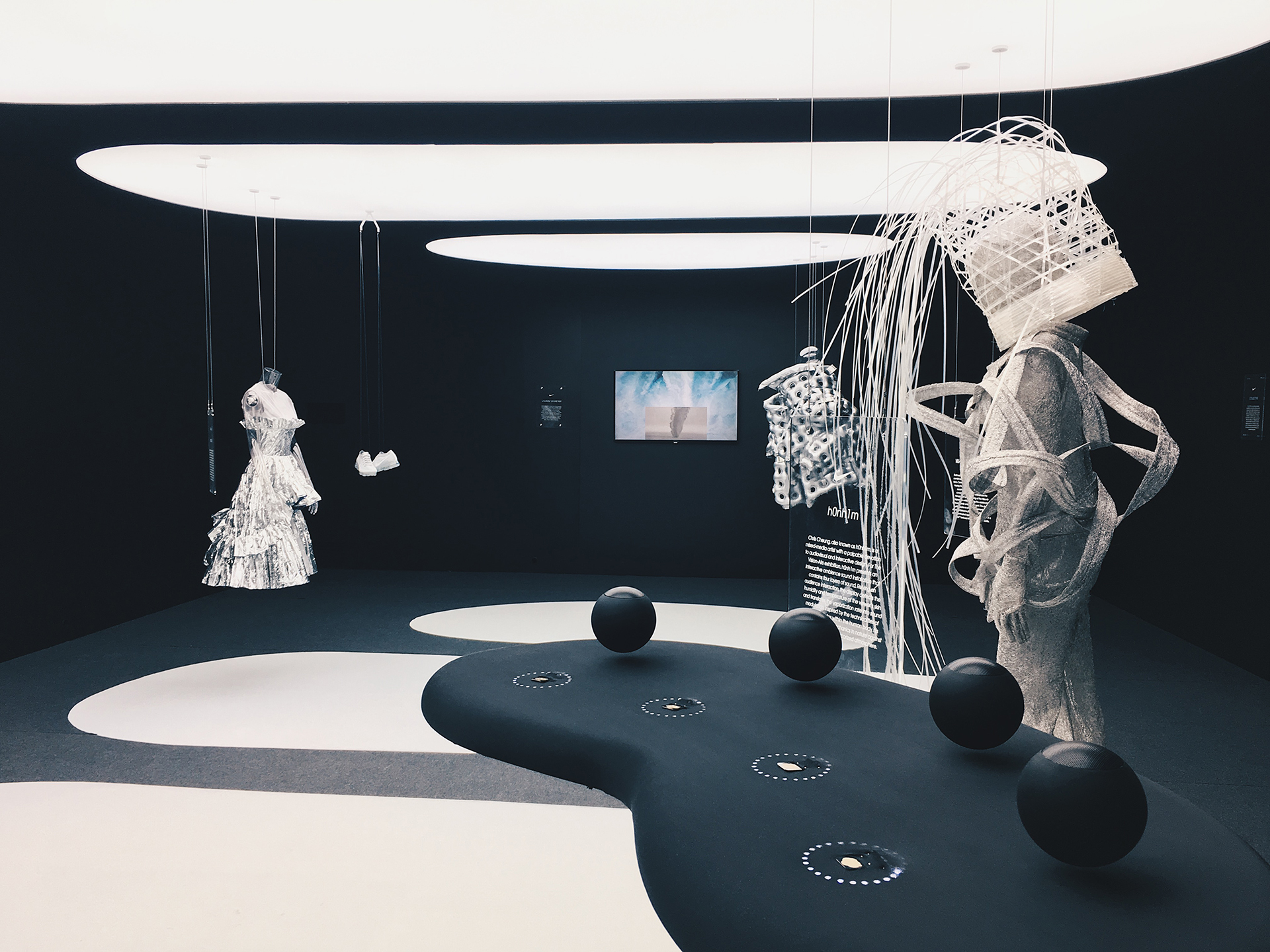
[OLD FALL 2018] 15-104 • Introduction to Computing for Creative Practice
Professor Roger B. Dannenberg • Fall 2018 • Introduction to Computing for Creative Practice
I chose Chris Cheung, namely, because of his presence in Hong Kong and in integrating technology and artwork. His works combine traditional and futuristic ideas, constantly exploring new mediums and finding aesthetics in technological intervention.

Alexander Chen is an artist at Google who is most well known for his personal work combining music and visualization techniques. At Google, he lead projects like the Chrome Music Lab and A.I machine learning experiments. I think the best way to understand Alexander Chen is to delve into some of his work. One of his the visualizations is for a Beach Boys song. He uses circles and colors to communicate complex auditory ideas. His code works by drawing circles for each note of the song; distinguishing a relationship between circumference of a circular surface and pitch. While this project was fascinating, I was most intrigued by his visualizations with the MTA. I thought his combination of sound with movement patterns was well done. In visualizing MTA patterns and hearing the intersections, it gave me a lot of insight.
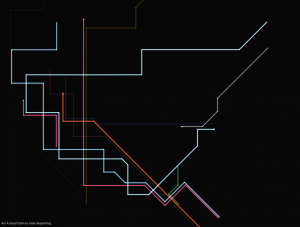
A screenshot of the MTA visualization conducted by Alexander Chen.
http://www.mta.me
Chris Sugrue holds a Masters of Fine Arts in Design and Technology from Parsons School of Design. She has worked as a creative engineer at the Ars Electronica Futurelab where she was the lead developer for a stereoscopic interactive dance performance with artist and choreographer Klaus Obermaier. Sugrue was the recipient of a year-long fellowship at the Eyebeam Art and Technology Center in New York, and has held artist residencies with Hangar in Barcelona, La Casa De Velázquez in Madrid and Harvestworks in New York.
Chris is an artist and programmer developing interactive installations, audio-visual performances and experimental interfaces. Her works experiment with technology in playful and curious ways and investigate topics such as artificial life, eye-tracking and optical illusions.
She presented a few of the works during the speech, most of which have one common ground that explores the vanishment of boundaries between virtual and reality. As an architect junior designer, I have the experience of dealing with the virtualization of objects within the digital space; however, it’s rarely the case when the digital represented works meet with the actual object in a mutual coexisting guesture. In Chris’s presentation, she has shown the power of how virtual imageries would have to interfere with the real sensatives. The most interesting project of hers is how human hands are scanned using cameras and projected on the screen with distorted fingers. I don’t even have to experience it in person to feel the distortion happening not only visually, but also psychologically with the person of the hand.

Also, what’s very inspiring about her works is how technology is involved. Most of the equipments are relatively simple to adopt and use. The codes are also not too complicated either. The focus of the works isn’t necessarily about the shwocase of tech but to achieve the minimal sense of technology involvement.
Sometimes “bugs” of the codes can even be a playful part of the experience. During her presentation of the work of the crawling bugs that travels from the screen to your body when you touch them, she describes how there’s an actual bug in the code that unable to retrieve the bugs that already off the screen. She talked about the kids tried to get the last bug from the screen. To me this is also another beautiful accident that adds to the spice of the whole experience.
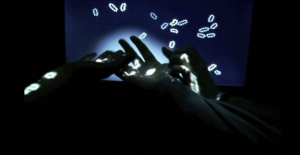
What I enjoy about her way of presenting is that there’s a very immediate fascination from her storytelling that’s easy to understand and reflect. And her visual representations are also very clear and interpretable. The use of music and video clips works together in a synergy that delivers the exact experience as you’re right at the place.
Artist Website – http://csugrue.com/
Original Eyeo 2014 Video
The pair Mimi Son and Elliot Woods have a studio called Kimchi and Chips. Son is a Seoul based artist specializing in storytelling through interaction design. She studied Interaction Design at Copenhagen Institute of Interaction Design and finished her Master of Art in Interaction Design at the Landsdown Centre of Middlesex University in London. Woods is a digital media artist from the UK. He was educated in physics and is using his background to produce sense-able phenomena from abstract domains.
They focus mostly on exploring the differences between material and immaterial. Using light as an immaterial to create material, many of their works are results of projection mapping techniques.
LINE SEGMENTS SPACE, 2013
My favorite piece is called “LINE SEGMENTS SPACE”. The gallery space is filled with a three-dimensional web of string. With careful projection mapping, the strings are lit up to create dynamic imagery. Through the use of light as immaterial, a complex form emerges.
My artist is Meejin Yoon who is a professor of architecture at MIT. She was born in Seoul, South Korea and attended Cornell for her bachelors and later received further education at Harvard. Yoon’s main area of focus is within the domain of responsive and interactive architecture. Her projects are innovative in her use of technology, especially new and novel technologies that have not been widely adopted.
The project I most admire is Swing time (above), located between the Boston Convention and Exhibition Center and D Street. The installation uses custom polypropylene and LED lights that are controlled based on movement. I thought this was quite unique given that most of the projects I have seen thus far in this class have used various algorithms. This piece is reactive and as such uses an internal accelerometer to measure acceleration forces. This combination of data and LED lightning creates beautiful displays that really light up a community.
Zach Lieberman – Eyeo Festival 2011 from Eyeo Festival on Vimeo.
Artist Zachary Lieberman is a a creative coder who utilizes technology to create new, unexpected realities. He has held positions at several creative firms around the world and he currently teaches at the Parsons School of Design. In addition, he studied Design and Technology at Parsons. According to his website, his goal is to surprise people using technology that “breaks down the fragile boundary between the visible and invisible.” Zachary Lieberman’s body of work is centered around using technology and computational methods to create art. In his presentation, Zach Lieberman discusses IQ font, which is his project that takes the movement of a driving car and turns it into a custom typeface. Lieberman worked with two typographers and a professional race pilot to design the font and he tracked the car movements with a software that he designed. I admire this project because it directly takes inspiration from a movement and translates that movement into art. In his presentation, Lieberman articulates his thoughts clearly and he effectively combines his speaking points with visuals. These strategies kept me engaged as a viewer, so I think I could implement these strategies when I talk about my own work.
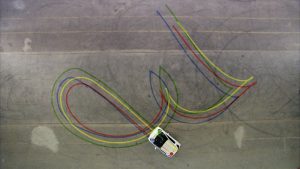
Reza Ali is a man who identifies himself as an explorer, designer, engineer, and researcher who pushes the limit of computational designs to achieve a new level of workflow. Beginning his career as an electrical and mechanical engineer, he began to branch outwards towards art and digital designs. His main workflow varies, but his core ideology is being able to switch between different mediums to produce the best product. One example he talks about is his project, Voronoi Puzzles. Within this project, it was important for him to start with codes and computational design, which would lead to him 3D printing. With 3D printing, he would begin working through a physical workflow, which would once again be put into a digital workflow. By learning new programs, he could easily turn his digital works into reality with his extensive works with 3D printers and CNC routers.
As architecture students in CMU, we have access to a wide range of digital fabrication machines to help bring our ideas to life. By transcending different workflows, he was able to improve his design constantly and improve his skill sets quality and quantity wise. Reza’s way of working is a complex yet very effective way of designing. Not only are just designers, but also an engineer that uses different codes and programs to help achieve our best design.
http://www.syedrezaali.com/
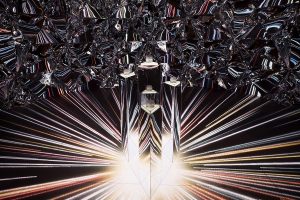
The work above is called Prismverse by Hong Kong media artist Chris Cheung. Chris is an artist who tries to integrate his artistic practice with his background in Chinese Philosophy. His work have common themes of integrating the traditional and the futuristic ideas as well as the aesthetics of technological intervention. Chris is currently the founder of an interdisciplinary creative studio called XEX, based in Hong Kong. Their work has been displayed all over Asia.
My personal favorite work of his is Prismverse. Prismverse is an installation that tries to immerse the viewer in infinity through sight and sound. Chris and XEX hoped that the diamond mirrors in the space would give the viewer a sense of the universe populated by infinite stars, and the omnidirectional speakers will present an ambient soundscape that immerses the viewer from all directions.
Eyeo 2015 – Meejin Yoon from Eyeo Festival on Vimeo.
Meejin Yoon: mystudio.us
I was interested in the works and creative practice of Meejin Yoon, the co-founder of Howeler Yoon Architecture, former head of the Department of Architecture at MIT, and dean of the College of Architecture, Art, and Planning at Cornell University. Trained as an architect, she had always been interested in the interactive aspect between people and public space, and responsiveness of space and creating relationships between content and context within the public sphere. In the Eyeo talk, she focused on her work in the field of interactive public space projects that “bridge issues of technology and play”. Her work spans across a wide range of topics, including responsive technologies, interactive technologies, smart materials, renewable energy, media-based public art, public engagement, and the public process.
At the beginning of her talk she explained how she is a very private person, but working with the public sphere has made her realize how the environment and responsive space can have a strong impact on her. I find her workflow of defamiliarizing and refamiliarizing interesting, and the psychologic studies she went through in order to create spaces, where people will intuitively interactive with, where people won’t be intimidated to touch elements in a public space. I’ve personally visited one of her projects, the Swing Time, in Boston. The project mimics the rubber tire swings that people would build in their backyards, refamiliarizing them with the concept, but also has an accelerator and an interactive lighting feature that responds to touch and speed.
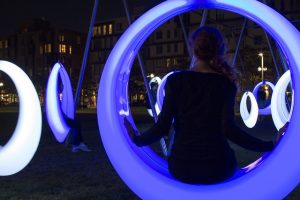
Kate Hollenbach is an artist, programmer and educator based in Los Angeles. She works for Oblong Industries during the time she gave the speech at INSTINT. Oblong is a Los Angeles based company founded in 2006 that dedicates in designing interfaces and building gestural interactions. Hollenbach was the former director of Design and Computation at Oblong and under her leadership, Oblong came up with several groundbreaking products truly pioneered in the gestural interaction industry, which the company and many believed is the future of computers.
Oblong’s first project “Tamper” was commissioned by the university museum of Cal State. It is an interface that uses multiple surfaces to do different tasks and users can use gestures to browse through different video clips displayed at the museum. The project requires users to wear gloves that have reflective markers on them which is captured by the many cameras installed in the display room. The project was a success and fueled Oblong to continue their endeavors in gestural interactions.
Kate Hollenbach’s speech at INSTINT 2014 where she displayes “Temper” at 04:35.
Mezzanine is the flagship product of Oblong that realizes conference room collaboration through building a multi-screen environment. Users can embed multiple video and sources from their own computers on the screens around the room and even project them to virtual locations. I really admire the organic aspect of Mezzanine where every interactive elements feel natural. The creators of Mezzanine utilizes animations and other tools to maximize the power of gestural interactions and make users comfortable with the new technology.
An introduction of Mezzanine by Oblong.